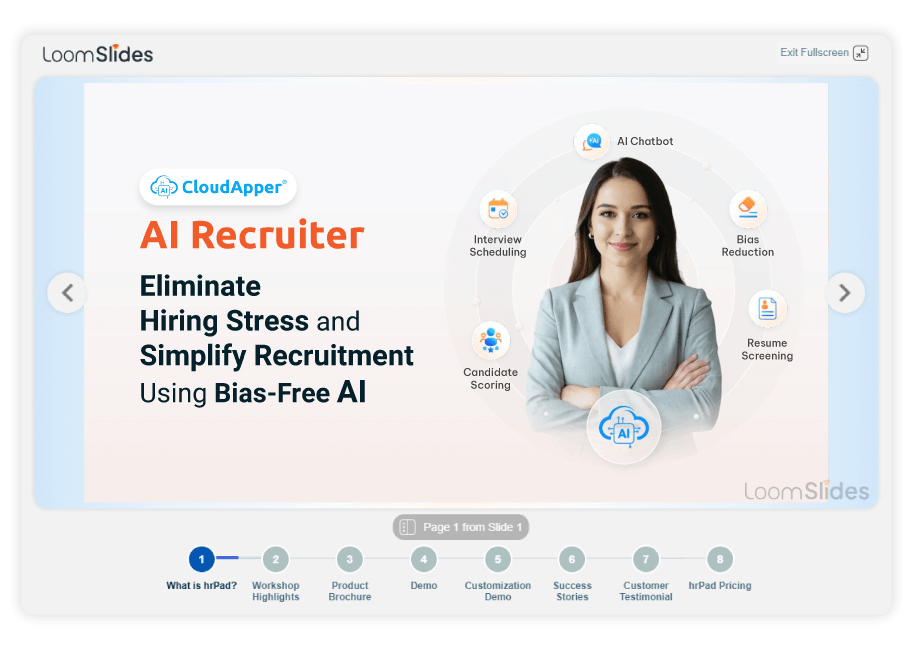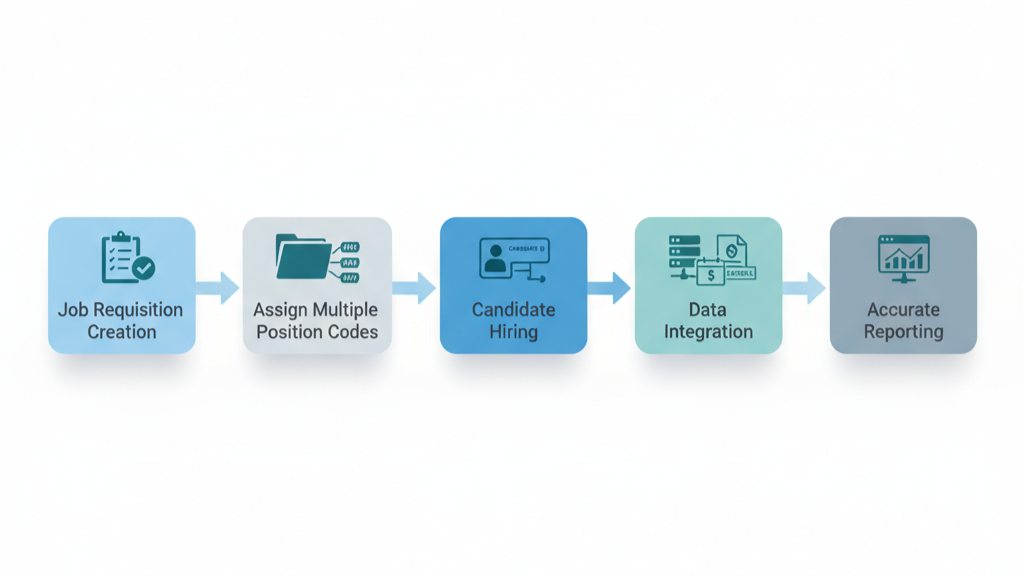For organizations hiring multiple candidates through a single requisition, aligning each hire with a unique Position Code is critical for accurate tracking and workforce planning. This article explores how CloudApper complements UKG Recruiting by enabling multi-position code mapping and reporting—helping teams maintain visibility and consistency across the hiring process.
Table of Contents
Recruiting in complex organizations often requires managing more than just job descriptions and requisitions. For many UKG users, the challenge lies in connecting hiring activity with organizational structures like budgets, headcount, and workforce planning. This is where Multiple Position Codes in UKG come into play.

For more information on CloudApper AI Recruiter for UKG visit our page here.
UKG Recruiting is a powerful system, but it traditionally supports one position code per requisition. While this setup works in straightforward hiring scenarios, it becomes limiting when companies open one requisition to fill multiple roles that should each be tied to separate position codes. Without flexibility, HR and recruiting teams struggle to maintain accurate reporting, reconcile filled positions, and align recruiting outcomes with workforce planning goals.
In this article, we’ll explore why multiple position codes matter, the challenges of relying on a single-code setup, and how CloudApper extends UKG Recruiting to handle these situations more effectively.
Why Multiple Position Codes Matter in UKG Recruiting
Position codes are more than administrative tags. In UKG and other HCM systems, they serve as anchors for workforce planning, budget control, and headcount tracking. Each full-time equivalent (FTE) role is usually tied to a unique position code that links recruiting activity with payroll, onboarding, and reporting.
When only one code is tied to a requisition, organizations encounter gaps in visibility. For example, if a requisition is opened to hire 10 nurses under one code, but each role actually has a different budget line or department, reporting becomes inaccurate. Headcount reconciliation becomes a manual task, and decision-makers lose real-time insight into vacancy status and position usage.
By allowing multiple position codes in UKG Recruiting, organizations can:
-
Keep recruiting aligned with position automation.
-
Maintain accurate tracking of filled and open positions.
-
Ensure budget allocations are respected at a granular level.
-
Improve reporting on time-to-fill metrics across departments.
This makes position code flexibility a necessity for employers who rely heavily on automation and precise workforce planning.
Common Use Cases for Multiple Position Codes
The need for multiple position codes is not limited to one industry. It’s a widespread challenge for HR and talent acquisition teams that manage large-scale or repetitive hiring. Here are some of the most common use cases:
High-Volume Hiring
Retailers, healthcare providers, and logistics companies frequently open one requisition to hire dozens of employees for the same role. While the job description is identical, each hire must be tied to a unique code for payroll and scheduling.
Seasonal or Project-Based Roles
Organizations hiring seasonal associates or project-based contractors often budget positions separately. Assigning them under one requisition without multiple codes creates reconciliation challenges later.
Healthcare and Regulated Industries
Hospitals and clinics may hire several nurses or technicians at once. Each position must be tracked separately to ensure compliance with staffing ratios, licensing requirements, and funding allocations.
Manufacturing and Shift-Based Staffing
Factories often hire multiple operators or line workers for the same shift. Each hire may tie back to a distinct cost center or operational budget.
In all of these cases, relying on a single code per requisition forces HR teams to use spreadsheets or manual workarounds—adding time, effort, and risk of error.
The Challenges of Single-Code Requisitions
UKG Recruiting is designed to associate one position code with each requisition. For simple roles, this is efficient. However, when hiring needs expand, the single-code limitation creates several problems:
-
Incomplete Tracking
Recruiters cannot accurately track which codes are filled and which remain open. This leads to discrepancies in vacancy reporting. -
Manual Reconciliation
HR teams must export requisition data into spreadsheets and manually assign hires to codes—a time-consuming and error-prone process. -
Inaccurate Reporting
Time-to-fill, cost-per-hire, and vacancy data lose accuracy when tied to only one code, especially in high-volume scenarios. -
Disconnect from Workforce Planning
Since many organizations tie budgets and headcount plans directly to position codes, a single-code requisition undermines workforce automation.
External research from SHRM and Gartner emphasizes the importance of accurate workforce data for compliance and decision-making. Without the ability to manage multiple position codes effectively, HR leaders risk gaps in compliance reporting and budget forecasting.
How CloudApper Extends UKG Recruiting Flexibility
The good news is that organizations don’t have to overhaul UKG Recruiting to solve this challenge. CloudApper provides customizations that are practical, flexible enhancement that allows companies to manage multiple position codes in UKG without disrupting existing workflows.
Here’s how it works:
-
Select or Import Multiple Codes: Recruiters can assign several position codes to a single requisition.
-
Map Hires to Codes: Each candidate hired under that requisition can be mapped to a specific position code.
-
Automated Data Flow: The data syncs into downstream processes such as onboarding, payroll, and scheduling.
-
Accurate Reporting: Reports reflect the real-time status of each position code—open, filled, or partially filled.
This enhancement ensures that organizations maintain accurate alignment between recruiting activity and organizational structure. Instead of working around the system, recruiters can extend UKG Recruiting’s capabilities to match their real-world hiring needs.
Step-by-Step Example: Managing One Requisition with Multiple Codes
Consider a retail company preparing for holiday season hiring. The HR team opens a single requisition for 12 seasonal associates. Each associate must be tied to a different position code linked to store budgets across multiple locations.
With native UKG functionality, this requisition would only allow one code—forcing the team to reconcile hires manually afterward. But with CloudApper:
-
The recruiter imports 12 position codes into the requisition.
-
As each hire is confirmed, the candidate is assigned to the correct position code.
-
The system updates workforce planning, payroll, and scheduling automatically.
-
Reports show which stores have filled positions and which still have open slots.
This streamlined approach eliminates manual reconciliation, supports compliance, and provides leadership with accurate staffing visibility.
Benefits of Managing Multiple Position Codes with CloudApper
The advantages extend beyond convenience. Organizations that implement this solution gain measurable improvements in recruiting efficiency and reporting accuracy:
-
Reduced Manual Work: Eliminates spreadsheets and workarounds.
-
Accurate Vacancy Metrics: Provides clarity on open vs. filled positions.
-
Better Alignment: Keeps recruiting data aligned with organizational budgets and headcount plans.
-
Compliance Support: Ensures accurate documentation for audits and regulatory reporting.
-
Improved Time-to-Fill Analysis: Tracks performance at the position-code level.
For HR leaders, these benefits translate into more informed decision-making and reduced administrative burden. For recruiters, it means more time spent sourcing and hiring instead of reconciling data.
Conclusion
For organizations using UKG Recruiting, managing requisitions with only one position code often creates reporting and alignment challenges. The ability to handle multiple position codes in UKG ensures that hiring activity reflects the reality of organizational structures, budgets, and headcount plans.
CloudApper provides the flexibility to extend UKG Recruiting without heavy customization—enabling recruiters to manage multiple codes, reduce manual work, and generate accurate reporting.
Whether you’re hiring seasonal associates, managing healthcare staff, or filling project-based roles, CloudApper ensures your recruiting workflows stay connected to the bigger picture.
Contact us today to explore how CloudApper can help you streamline multiple position code management in UKG Recruiting.
FAQs: Multiple Position Codes in UKG
What are position codes in UKG Recruiting?
Position codes are unique identifiers that tie each job/role to a specific budget, department, and headcount plan in UKG. They enable accurate vacancy tracking, reporting, and workforce planning.
Can UKG Recruiting handle multiple position codes in one requisition?
By default, UKG Recruiting associates one position code with a requisition. Many organizations extend this by using CloudApper to manage multiple position codes within a single req.
Why would I need multiple position codes under a single requisition?
Batch or high-volume hiring (e.g., nurses, seasonal associates, project teams) often requires separate budget lines or departments per hire. Multiple position codes keep payroll, headcount, and reporting accurate.
How does CloudApper support multiple position codes in UKG?
CloudApper lets recruiters select or import multiple position codes for one requisition, map each hire to a specific code, and sync that data to onboarding, payroll, and analytics without manual reconciliation.
What are the benefits for HR and recruiting teams?
Reduced manual work, accurate vacancy metrics, alignment with budgets and headcount plans, improved time-to-fill insights, and stronger audit/compliance reporting.
Does mapping hires to position codes affect payroll or onboarding?
Yes—positively. When each hire is tied to the correct position code, downstream processes like onboarding, payroll, and scheduling reflect accurate assignments from day one.
Is this only useful for high-volume hiring?
No. Any organization that tracks roles by unique position codes can benefit, including healthcare, retail, manufacturing, and project-based environments.
Can multiple position codes improve compliance and audits?
Yes. Clear code-level tracking supports internal audits, staffing ratio requirements, and regulatory reporting by showing which positions are filled, open, or pending.

















